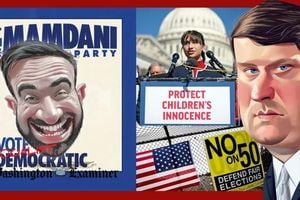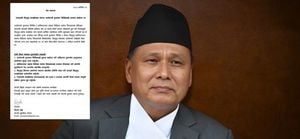Every Friday afternoon since March 2025, the corner of 195 and S. Eagleville Road in Mansfield, Connecticut, has become a familiar scene of protest. Dozens of residents—most in their sixties and seventies—gather for an hour, waving handmade signs and sharing sharp words about former President Donald Trump and his administration. On October 3, the crowd swelled to 58, their placards broadcasting messages like “Pedophilia is not presidential,” “Grab him by the Epstein files,” and “Deport criminal Trump.” Passing cars honked in support, their drivers nodding or waving in solidarity.
The organizer behind these weekly demonstrations is Rikke Wassenberg, a retired University of Connecticut professor. For her, the cause is clear and urgent. “Our media is the only media that doesn’t stand up and say stuff,” Wassenberg told The Daily Campus. Her main concern is free speech, but she’s equally troubled by what she sees as rampant misinformation. “I’m embarrassed that the American public is so misinformed,” she said, gesturing to the crowd of sign-holders and the steady stream of supportive honks.
Wassenberg isn’t alone in her worries. Jorge Guerra, a former track coach and teacher at E.O. Smith High School, has attended the protests since they began. He sees his participation as a moral imperative. “There’s so much wrongdoing. You can’t just sit back and be idle with what’s going on,” Guerra explained. “We are speaking out while we can.”
Pat Morgan, who splits her time between Hawaii and Oregon, joined the Connecticut protest while visiting a friend. She’s made it a habit to join demonstrations against Trump wherever she travels. Morgan didn’t mince words about her view of the former president, calling him a “crazy autocratic dictator, narcissist, mentally ill, mentally compromised man in charge.” She went further, criticizing the U.S. Supreme Court for failing to defend the constitution: “They were the ultimate voice. They were the last check of the checks and balances, which no longer exists, because Trump has taken over Congress.”
For Morgan, the state of the country has become so distressing that she’s considering emigrating. “This is no longer the country that they grew up in,” she said, noting that most protestors are between 60 and 70 years old. She also lamented the influence of conservative media: “Fox News does nothing but promote [Trump’s] lies, and you’ve got 50% of Americans who only seem to watch Fox News and believe everything he says, and it’s absolutely scary.”
While these protests in Mansfield are relatively small and peaceful, they echo a much larger and more turbulent chapter in recent American history. According to The New York Times, the summer of 2020 saw President Trump deploying federal law enforcement to Portland, Oregon, in response to nightly demonstrations following the murder of George Floyd. The operation, dubbed “Operation Diligent Valor,” began on June 26, 2020, and brought agents from Immigration and Customs Enforcement (ICE), the Border Patrol, and other federal agencies into the city’s streets—agents who, as many pointed out, had little experience with urban crowd control.
The result was a dramatic escalation. What began as protests for racial justice and against police violence soon grew into massive rallies—tens of thousands strong—focused on opposition to the federal presence and Trump’s administration. The presence of federal officers not only drew more protesters but also attracted counterprotesters eager to show support for Trump, setting the stage for violent confrontations. Property was damaged, government buildings were set on fire, and clashes between right-wing and left-wing demonstrators became a nightly occurrence.
“All those people coming out each night gave the feds justification for doing whatever they wanted,” said Luis-Enrique Marquez, a frequent Portland demonstrator. The city’s police, meanwhile, were hamstrung by restrictions that prevented them from coordinating with federal agencies. Chief Bob Day of the Portland police recalled, “We were just very isolated in many ways—from our City Council, from our state government, from the people out protesting.”
The lack of communication and coordinated strategy made it difficult to separate peaceful demonstrators from those intent on violence. “Embedded in that crowd were people—not many, but still, people who were willing to set a building on fire with people in it,” said Renn Cannon, the FBI’s special agent in charge for Oregon in 2020. The escalation of tactics by federal agents only served to blur the original purpose of the protests. As Teressa Raiford, founder of a nonprofit focused on racial issues and police oversight, observed, “A lot of the work we’d done to dismantle white supremacy got sold out. The priority was, ‘We’ve got to get rid of Trump.’”
After a month of nightly chaos, the crisis was finally defused through back-channel negotiations between Oregon’s Democratic governor, Kate Brown, and Vice President Mike Pence. Federal forces were replaced by Oregon State Police, and the largest demonstrations subsided. Since then, Portland’s police department has overhauled its approach, introducing “dialogue officers” to serve as liaisons with protest organizers and donning less intimidating uniforms to de-escalate tensions. The goal now is to avoid the adversarial environment that dominated 2020.
But the lessons of Portland’s summer of unrest remain painfully relevant. As The New York Times reports, Trump has signaled his intention to send National Guard troops to cities he deems “out of control,” citing the need to protect federal buildings—this time, ICE facilities rather than courthouses. The move has reignited fears among activists and city officials that history is poised to repeat itself. “It’s hard for me to give you lessons,” said Portland police sergeant Aaron Schmautz. “All I can really remember is how tired and traumatized we all were.” Marquez, the seasoned protester, put it more bluntly: “The biggest lesson, to me, is that this is going to get bad.”
City leaders in Oregon are determined not to make the same mistakes. They’ve enlisted business owners to file legal briefs opposing the activation of National Guard troops, worried about the economic impact of renewed unrest. They’ve also taken to the media, working to counter Trump’s narrative that Portland is “war-ravaged”—a perception that, as sociologist Randy Blazak pointed out, can be as damaging as reality itself. “You can roll your eyes all you want,” Blazak said, “but perception matters.”
Meanwhile, other cities are grappling with their own challenges. In Chicago, a recent shooting involving ICE officers and a protester has highlighted the dangers of poor coordination between local and federal law enforcement. Mayor Brandon Johnson has called for an investigation, and police chief Larry Snelling has expressed hope for better communication to avoid an “adversarial environment.”
Back in Mansfield, the protestors’ numbers may be modest, but their determination is clear. They see themselves as the conscience of a country in flux, unwilling to remain silent in the face of what they view as injustice and the erosion of democratic norms. Whether their weekly gatherings can help steer the national conversation—or if the lessons of Portland will be heeded elsewhere—remains to be seen. But as the sun sets on another Friday in Connecticut, the honking continues, and the signs remain aloft.




